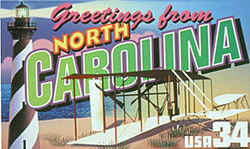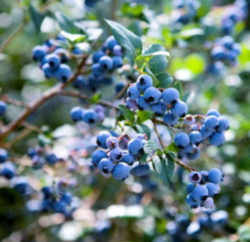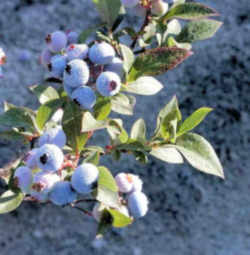
North Carolina Symbols
North Carolina State Blue Berry
Blueberry

(Vaccinium corymbosum)
Adopted in 2001.
In 2001, the General Assembly named the strawberry as the official Red Berry of North Carolina, and named the blueberry, (Vaccinium corymbosum,) as the official Blue Berry of the state (Session laws, 2001, c. 488). The same session law declared the Scuppernong grape to be North Carolina's official state fruit.
The session law itself explains how important these two berries are to the agricultural economy of the state of North Carolina. In the year 2000, strawberries brought in over $17,000,000, while the blueberry created over $18,000,000 in North Carolina revenues.
Strawberries (genus fragaria) are high in Vitamin C and A, and supply 8% of the RDA for Iron. There are only 60 calories in a cup of fresh berries and zero grams of fat. A cup of blueberries (genus vaccinium) supplies 50% of the RDA for Vitamin C, as well as 22% of the fiber recommended for a healthy diet.
Both berries are grown throughout the state, and consumers can pick their own berries at farms from one end of the North Carolina to the other.
North Carolina Blue Berry: Blueberry

Vaccinium corymbosum, the northern highbush blueberry, is a species of blueberry native to eastern North America, from the Great Lakes region east to Nova Scotia, and south through the Northeastern United States and Appalachian region, to the Southeastern United States in Mississippi. Other common names include blue huckleberry, tall huckleberry, swamp huckleberry, high blueberry, and swamp blueberry
Vaccinium corymbosum is a deciduous shrub growing to 6-12 feet (1.8-3.7 m) tall and wide. It is often found in dense thickets. The dark
glossy green leaves are elliptical and up to 5 centimetres (2.0 in) long. In autumn, the leaves turn to a brilliant red, orange, yellow, and/or purple.
The flowers are long bell or urn-shaped white to very light pink, 0.33 inches (8.4 mm) long.
The fruit is a 0.25-0.5 inches (6.4-12.7 mm) diameter blue-black berry. This plant is found in wooded or open areas with moist acidic soils
Characteristics of the Blueberry
Habit and Form
- a deciduous, twiggy shrub
- open, leggy crown
- 6" to 2' tall
- 2' wide
- medium texture
- moderate growth rate
Summer Foliage
- alternate leaf arrangement
- simple, deciduous shape
- lanceolate leaf shape
- 0.33" to .75" long
- serrulate leaf margins
- dark green leaf color
Autumn Foliage
- reddish, bronze fall color
- showy
Flowers
- white flowers
- 0.25" diameter
- blooms in May
- showy
Fruit
- bluish-black fruit
- sweet and edible
- up to 0.5" across
- matures in mid- to late-summer
Act Adopting The Official Fruit and Berries of North Carolina.
PART I. NORTH CAROLINA'S HERITAGE OF FARMING
Whereas, North Carolina's economy originated and developed as an agrarian economy with a cornucopia of fruits and vegetables; and
Whereas, the State takes great pride in its rich heritage of farming; and
Whereas, there are still many families who base their livelihood in farming and who are continuing the North Carolina tradition of producing goods
from our land; and
Whereas, one of the main sources of agricultural production in the State is the production of fruits and berries of several varieties; and
PART II. THE SCUPPERNONG GRAPE.
Whereas, North Carolina is the home of our nation's first cultivated grape, the Scuppernong; and
Whereas, the Scuppernong grape was named after the Scuppernong River in North Carolina; and
Whereas, British explorers in 1584 and 1585 reported to Queen Elizabeth and Sir Walter Raleigh that the barrier islands of what is now, in part, Roanoke
Island were full of grapes and that the soil of the land was "so abounding with sweet trees that bring rich and most pleasant gummes, grapes of
such greatness, yet wild, as France, Spain, nor Italy hath not greater..."; and
Whereas, Sir Walter Raleigh's colony discovered the famous Scuppernong "Mother Vineyard" on Roanoke Island, a vine that is now over 400 years
old and has a trunk over two feet thick; and
Whereas, the State toast, penned in 1904, references North Carolina as the land "[w]here the scuppernong perfumes the breeze at night,";
and
PART III. THE STRAWBERRY AND THE BLUEBERRY.
Whereas, there are over 1,700 acres of strawberries and over 3,600 acres of blueberries harvested in North Carolina each year; and
Whereas, in 2000, strawberry growers in the State produced 23,000,000 pounds of strawberries, yielding $17,325,000 in revenues; and
Whereas, in 2000, blueberry growers in the State produced 17,500,000 pounds of blueberries, resulting in an increase in the State's economy of over
$18,000,000 in revenues; and
Whereas, these delicious berries are a good source of vitamins, a number of life sustaining minerals, and dietary fiber;
Whereas, the blueberry is an antioxidant, which has been proven to reduce cholesterol and lower the risk of heart disease; and
Whereas, each year the Town of Chadbourn in Columbus County hosts the North Carolina Strawberry Festival, which is one of the most celebrated traditions
in the State; and
Whereas, the State of North Carolina does not have an official fruit nor an official berry; Now, therefore,
The General Assembly of North Carolina enacts:
SECTION 1. Chapter 145 of the General Statutes is amended by adding a new section to read:
"§145-18. State fruit and State berries.
(a) The official fruit of the State of North Carolina is the Scuppernong grape (Vitis genus).
(b) The official red berry of the State is the strawberry (Fragaria genus).
(c) The official blue berry of the State is the blueberry (Vaccinium genus)."
SECTION 2. This act is effective when it becomes law.
In the General Assembly read three times and ratified this the 5th day of December, 2001.
s/ Beverly E. Perdue
President of the Senate
s/ James B. Black
Speaker of the House of Representatives
s/ Michael F. Easley
Governor
Approved 6:58 p.m. this 16th day of December, 2001
North Carolina Law
The law designating the blueberry as the official North Carolina state blue berry is found in the North Carolina General Statutes, Chapter 145 Section 145-18
Chapter 145 - State Symbols and Other Official Adoptions.
Section 145-18.
§ 145-18. State fruit and State berries.
(a) The official fruit of the State of North Carolina is the Scuppernong grape (Vitis genus).
(b) The official red berry of the State is the strawberry (Fragaria genus).
(c) The official blue berry of the State is the blueberry (Vaccinium genus).
(2001-488, s. 1.)
Taxonomic Hierarchy: Blueberry
Kingdom: Plantae - Plants
Subkingdom: Tracheobionta - Vascular plants
Superdivision: Spermatophyta - Seed plants
Division: Magnoliophyta - Flowering plants
Class: Magnoliopsida - Dicotyledons
Subclass: Dilleniidae
Order: Ericales
Family: Ericaceae - Heath family
Genus: Vaccinium L. - blueberry
Species: *

List Official US State Foods






